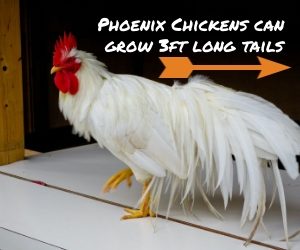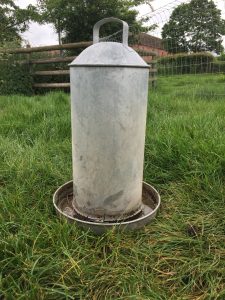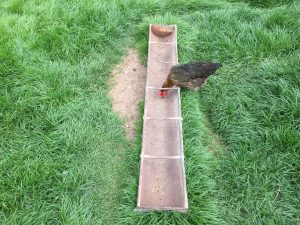Breed History
The Phoenix is an amazing breed with a rich interesting history. So how did it all start?
Well the Phoenix was developed in Germany circa 1880; but your thinking they don’t look like a typical German chicken breed – you’d be right.
They have been bred from a Japanese breed called Onagadori, famous for its long tail. The Japanese have been breeding what they call ‘ornamental garden birds’ for a thousand years. What’s incredible is the tail feathers of some of these breeds could reach up 30ft (9.1m).
Yes you read that right – 30 feet!
The idea being ‘high society’ in Japan, (i.e the rich), would throw garden parties and these birds would provide entertainment for their guests, being that they have very long tails and exquisite coloring. To have chickens so rare and unique was a sign of wealth and ‘good taste’!
So fast forward a few years, and Germans started hatching Onagadori eggs to try to get in on the act. They very quickly realized that the birds were prone to poor health and delicate. This wasn’t great if you’ve spend a lot of money buying fertile eggs to hatch this breed.
The Germans needed to improve the health and stamina of the birds whilst maintaining the beautiful Onagadori traits.
The answer…
They bred local German ‘Game Birds’ with the Onagadori to create what we now called the Phoenix.
Phoenix Genetics
The Onagadori had a very unusual set of genes, firstly that allowed for such spectacular tail grow, but also a recessive gene that keeps it from molting its feathers. Sadly during the cross breeding with the German game birds to develop the Phoenix, these genes were lost!
So the Phoenix will never grow the tails feathers as long as the Onagadori. Shame.
The Phoenix tail length will still reach a length of a couple of feet (91cm), so fear not if you are looking to add a long tail showy breed to you flock! (N.B its mature roosters that grow tails to this length, not the females).
They aren’t cold hardy, meaning they can’t handle the cold well. They are extremely popular in the U.S and rather surprisingly in India too.
Eggs
Size
Small
Color
Cream
Production per year
Low (60-100)
When do they start laying eggs?
Around 24 weeks (6 months)
Phoenix Characteristics
Temperament / Are they good as pets?
They do make for great pets actually but ideally you want them from chicks. Hand reared Phoenixes tend to be friendly and great with children. They can be, if not hand reared, very independent, but not unfriendly at all. They make for great mothers and will often raise offspring that aren’t their own as they are very caring and loving.
This means they are a great breed for children, but be aware some very young children want to pick up and pull their tail. Its so long and beautiful you cant really blame them. So keep an eye on young children around this breed.
How do I tame Phoenix chickens?
Very easy to tame, especially from chicks. Handling them 2-3 times a day when young is the best way. That way they built up lots of trust with you. You can pick them up, they will let you but be careful of that long tail, so it doesn’t get damaged!
If you have an adult Phoenix a good way to tame it is the cupboard love method. Slowly go near them and throw them treats. Soon they will be coming right up to you to eat treats at your feet. Next they will be eating them out of your hands. This process of taming can take a few days or couple of weeks, every bird is different.
How many do I need to buy?
The recommended mating ratio with this specific breed is 9:1. So that’s 9 females to every one male. Bantam Phoenixes are slightly different, the ratio is less at 8:1.
I never suggest to purchase just one chicken. One chicken would just get lonely. They are naturally social creatures and love company whether its human or other chickens! The best number for a backyard flock is 6. From here you can scale up quite easily. Remember keeping chickens is addictive – trust me!
How much space do they need?
The way I think of space with Phoenix’s is think of it in terms of ‘turning circle’. They are small birds with big tails so need a minimum of 4ft in each direction. 3ft for a fully gown tail and 1ft of space infront. This is an absolute minimum.
Will they mix with my other chickens?
Yes, but they are a docile breed so if you have a heavy weighting in your flock of alert active birds, so breeds like Rhode Islands & Welsummer be careful. I have seen Phoenixes get picked on. This is rare however, but worth considering.
They are great friends with Silkies and other docile breeds. The Bantams are brilliant with nearly all other bantams, they make a great match up.
Appearance
Three standard colors are recognized by the American Poultry Association (APA) these are below. Phoenixes have a bright red, single comb with five distinct upright points. They are easy to spot as they have, in both sexes, pure white oval earlobes.

Silver Phoenix Chickens
The silver variety was accepted by the American Poultry Association (APA) in 1965. Its probably the most popular variety with its long tail and shiny feathers being adored worldwide.
The gold was accepted by the APA in 1983 but only recently has the black breasted red been accepted by the APA, this was in 2018.
Weight
Standard Cock 5.5 lb. (2.5 kg) and the female hens weigh 4 lb. (1.8 kg)
Bantam Cock 26 oz. (740 g), with the Hens weighing 24 oz. (680 g)
Feeding
What should I feed them?
As chicks they need to be fed ‘chick crumb’ or ‘chick starter’. It’s the same thing just called slightly differently. They will eat this upto 6 weeks then they need to switch onto something different called ‘growers mash’.
From 6 weeks onwards there development will be extremely fast and growers mash contains all the right nutrients and minerals to aid this growth.
At around 22 weeks they will need something different again. They will start to go through the process of laying an egg. Young chickens at this age are said to be on the ‘Point of Lay’ usually abbreviated to (POL).
I switch them onto ‘Layers Pellets’ at 22 weeks as it gives them a couple of weeks to get all the nutrients from the new feed in them, as laying their first egg is an energy consuming business! That’s just a little breeders tip. I always make sure mine are more than ready, providing them with the best quality feed at the right times, after all this leads to the best quality eggs! Yum!
There is a slight difference with Bantam Phoenixes, instead of ‘layers pellets’, they eat Bantams layers pellets. They contain the same ingredients, its just the bantam pellets are smaller than standard ‘layers pellets’. Being smaller this makes them easier to swallow.
Id recommend a supplement for Phoenix’s that helps keep their lovely feathers in good condition.
Although its as much about their coop conditions as it is about supplements. [Ill come onto coops further down as the Phoenixes have a slightly different requirement]
How much should I feed them?
As chicks and young adults, so from a few days old week right up to the POL they should always have feed available. Especially as chicks they haven’t developed a feeding pattern so might not eat during the day and only eat and night or vice versa. Having feed there constantly in a feeder means they can eat whenever they are hungry.
As adults they will eat 2.8oz (80g) to 4.2oz (120g) per day. At this age you can constantly have feed in the feeder. Although I don’t encourage this as it just leads to rodent problems! So what I do is weigh out, only roughly, the right amount of feed and give this to them each day.
What can’t they eat?
Chickens can’t eat chocolate and beans, this is regardless of breed, it’s all chickens. Dried beans are infact worse than non-dried. Beans or chocolate are deadly to chickens it causes them to cardiac arrest. There’s a funny coincidence that dogs cant eat chocolate either, its harmful to them aswell.
Beans are the main offender here, they often sneak in when feeding chickens scraps from the table.
Did you know in the UK its illegal to feed chickens scraps…?
If you are feeding your chickens scraps be really vigilant that’s there no beans. Plus, make sure if your chickens are free range they can get into, say, vegetable beds and find some bean plants that way……
What do I need to keep chickens?
Well, you’ll need the what I call the BIG 3:
1. Coop
Phoenix chickens need 6ft+ high roosting bars to accommodate for their long tail. It also just naturally where they feel the safest. Its probably due to the fact that game fowl are their ancestors. High up is safest in the wild, whereas low down makes you an easy target for predators.
Phoenix chickens also need a dry and well bedded coop in order to maintain the quality of their their feathers. So for these two points they are a little trickier than other breeds. However the Phoenixes are definitely worth it. The color of the Silver Phoenix is amazing and the tail at up to 3ft is remarkable. They should be a high contender for your backyard flock.
2. Waterer
Chickens need access to clean fresh drinking water at all times. The waterer should be placed on flat ground, in the shade where it is less likely to be knocked over. Don’t buy a design where chickens can climb and sit on top of it. This will lead to it being knocked over and your chickens having no water. In a hot climate this will quickly lead to heat exhaustion and at worst they will perish.
A great little tip that I used to do for my Silver Phoenix Chickens was to put a tea spoon of apple cider vinegar in the water. It would to get the feathers looking amazing and also is said to maintain good natural digestive health. Id add a teaspoon to about a gallon (4.5l) of water.
I use a metal waterer and you should get one for a few reasons:
- They last sooo much longer than a plastic ones. Imagine chickens pecking into a plastic one all day long over a year. They just crack and break and your lucky if you get a year use from them. My metal one is decades old and still going strong. Also plastic in the cold and heat will crack under stress and research know shows that plastic can leach into water with harmful toxic chemicals.
- Metal is heavier than plastic so is less likely to be knocked over meaning your chickens won’t have to go without.
- It keeps the water cooler for longer. Chickens actually prefer cool water, its true! So get a galvanized chicken waterer and your flock will thank you for it.
Metal is easier to clean than plastic, let me explain why. I use no chemicals when I clean the waterers as I can’t risk any chemicals, not even a speck remaining when I fill it back up with drinking water. This could make the chickens seriously ill. So what do I do?
I use a thousand year old trick – boiling water! Surely you’ve heard of it.
Don’t be a fool and buy these ‘waterer cleaning’ products, they are nonsense. Boiling hot water will kill any germs and bacteria.
Using boiling water makes it quick and easy to sanitize anything. If you had a plastic waterer the boiling water would crack it. Maybe not right away, but within a couple of months.

3. Feeder
Again id by a metal one for all the reasons mentioned above. My metal ones are still going strong. The plastic ones just get cracked and chicken peck at each individual piece of feed. Thats just how they eat. You multiply that cross a few chickens and across a couple of months and it results in them cracking the plastic.
Do I need a feeder, can’t I just throw the feed on the ground?
Don’t throw feed on the ground. I do it, but ill come to explain why in a minute. Feeding them on the ground means they could leave bits, which very quickly attract rodents. Rodents could spread disease amongst your flock. Not good.
So what I do is put 90{cfcd481556a8b43fba6af451761032bd323e94372a0c1e607} of the feed in the feeder and scatter the remaining on the ground.
(I only scatter it if the ground is dry as water or moisture will make the feed go bad very quickly.)
This way they have something to scratch around at an it keeps them entertained. Mine are all free range so have plenty of time to forage during the day aswell.

Breed Recap
- Lovely long tails growing upto 3ft
- Docile & friendly
- Available in Bantam
- Require 6ft+ roosting perch
Ok that’s it, you’re ready to get some Phoenix chickens in your flock and be the envy of everyone!
Where can I buy Phoenix Chickens?
In the U.S try Cackle Hatchery they stock over 5 varieties of Phoenix’s, including Silver Phoenix chickens. Cackle are a family run business with 3 generations of knowledge and ship out across all states. They sell cute day old chicks and adults.
Have a look at their Bantam Phoenix’s here too!
They also have a variety of other longtail chickens too……

